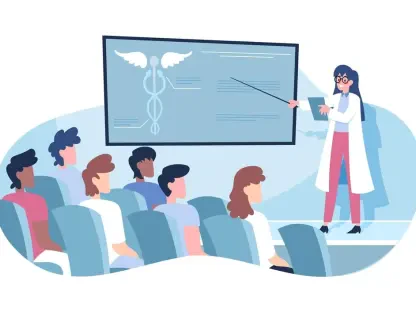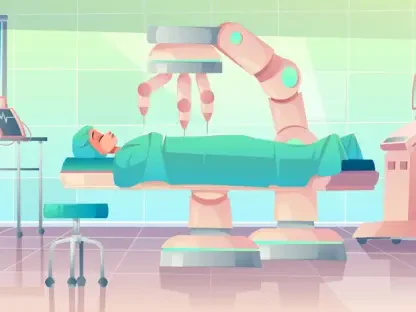Overview of Health IT Challenges and Opportunities
In an era where healthcare data breaches expose millions of records annually, the health information technology (IT) sector stands at a critical juncture, tasked with safeguarding privacy while ensuring seamless data exchange. The urgency to modernize systems has never been clearer, as patients demand easier access to their health records and providers seek real-time tools for better decision-making. This pressing need for balance between security and accessibility sets the stage for transformative initiatives within the industry.
Health IT plays a pivotal role in modern healthcare, enabling everything from electronic health records to telemedicine solutions that improve patient outcomes. The landscape, however, is fraught with challenges, including fragmented systems and persistent privacy risks that hinder efficient care delivery. Addressing these issues requires innovative approaches that prioritize both interoperability and robust data protection.
The Assistant Secretary for Technology Policy (ASTP), housed within the U.S. Department of Health and Human Services, spearheads efforts to tackle these systemic gaps through strategic programs. Among these, the Leading Edge Acceleration Projects (LEAP) in Health IT stands out, focusing on pioneering solutions for privacy and interoperability. Recent awards to key players like the Healthcare Information and Management Systems Society (HIMSS) and the National Opinion Research Center (NORC) underscore a commitment to driving meaningful progress in this space.
Key Innovations Shaping Health IT
Emerging Trends in Privacy and Interoperability
A significant trend reshaping health IT is the push for secure, patient-centered data exchange, exemplified by frameworks like the Trusted Exchange Framework and Common Agreement (TEFCA). This initiative aims to standardize how health information is shared across diverse systems, ensuring consistency and trust. As adoption grows, TEFCA serves as a foundation for reducing silos that have long plagued the industry.
Innovations such as Individual Access Services (IAS) and Fast Healthcare Interoperability Resources (FHIR) subscriptions are also gaining traction as essential tools. IAS empowers patients by simplifying access to their health data, while FHIR subscriptions enable real-time updates for clinical applications. Together, these advancements promise to bridge gaps between patients and providers with unprecedented efficiency.
Technologies like federated credentials and reusable identity tokens further enhance security by streamlining authentication processes. Coupled with real-time decision support systems, these tools address consumer expectations for immediate, secure access to personal health information. The convergence of such trends signals a future where health IT can meet both technical and user-driven demands.
Impact of Current LEAP Awards
The latest LEAP in Health IT awards, totaling up to $2 million, target critical areas like IAS adoption and FHIR subscription readiness, with projects spanning from now until 2027. These initiatives are designed to deliver practical solutions that can scale across the healthcare ecosystem. The funding reflects a strategic emphasis on overcoming longstanding barriers through focused innovation.
HIMSS, one of the award recipients, is working on simplifying identity proofing to ease patient access to health records via IAS. Their project includes developing operational toolkits for stakeholders, aiming to minimize friction in implementation. This effort could set a new standard for how patients interact with their data securely and efficiently.
Meanwhile, NORC is advancing a prototype for postpartum hypertension monitoring using FHIR subscriptions to enable real-time interventions. By automating patient enrollment and responses to health alerts, this project demonstrates the potential of FHIR to transform clinical workflows. Expected outcomes by 2027 may well influence broader standards, paving the way for wider adoption of such technologies.
Challenges Hindering Health IT Progress
Adoption of IAS and interoperable systems faces significant hurdles, including technical complexities that slow integration into existing infrastructures. Many healthcare organizations struggle with outdated systems ill-equipped to handle modern data exchange protocols. This mismatch creates operational friction that delays progress across the board.
The rollout of TEFCA, while promising, has encountered sluggish participation from stakeholders hesitant to overhaul established processes. Resistance often stems from resource constraints and a lack of clear incentives for early adopters. Targeted solutions, including streamlined guidelines and support mechanisms, are essential to accelerate engagement.
Security remains a paramount concern, as balancing accessibility with stringent privacy measures proves challenging in patient data exchange. Breaches and unauthorized access risks loom large, necessitating robust safeguards that do not impede usability. Strategies like reusable workflows and automated authentication systems offer potential pathways to address these dual priorities effectively.
Regulatory and Compliance Framework in Health IT
TEFCA serves as a cornerstone for secure and interoperable health data exchange, providing a structured approach to compliance across diverse entities. Its guidelines help ensure that data sharing adheres to consistent standards, fostering trust among participants. As a regulatory backbone, it shapes how health IT evolves in alignment with national goals.
Federal policies and privacy laws further influence health IT practices, mandating strict adherence to protect sensitive information. These regulations create a framework within which innovation must operate, balancing advancement with accountability. ASTP and LEAP initiatives align closely with such mandates, embedding compliance into their project designs.
Evolving regulations also impact how projects approach identity verification and data sharing, requiring adaptability to stay ahead of policy shifts. The focus on security and trust within these programs ensures that outcomes reinforce regulatory objectives. Over time, this alignment could streamline compliance burdens for industry players navigating a complex legal landscape.
Future Directions for Health IT Innovation
Looking ahead, the health IT sector appears poised for transformation, driven by the current LEAP awards and their emphasis on practical solutions. Outcomes expected by 2027 may redefine how interoperability and privacy are addressed at scale. These projects build on a legacy of innovation that continues to push boundaries in healthcare technology.
FHIR subscriptions hold particular promise for revolutionizing clinical care through real-time data access and automated interventions. As tools like these mature, they could enable providers to respond swiftly to patient needs, enhancing outcomes. The ripple effects might extend beyond individual applications to reshape entire care delivery models.
Emerging partnerships, such as the HealthEx platform collaboration with Epic Systems, highlight growing momentum in patient-directed data access. Combined with global trends toward patient empowerment and technological advancements, these developments suggest a dynamic future. The ongoing focus on collaboration and cutting-edge tools will likely sustain progress in creating a more connected health IT ecosystem.
Closing Reflections and Path Forward
Reflecting on the strides made through the recent ASTP awards, it becomes evident that targeted funding and innovation tackle critical gaps in health IT privacy and interoperability. The dual emphasis on empowering patients via IAS and equipping providers with real-time tools like FHIR subscriptions marks a significant step forward. Projects led by HIMSS and NORC lay groundwork that promises to influence standards by 2027.
As the industry moves forward, stakeholders need to prioritize investment in scalable, secure solutions that can adapt to evolving needs. Collaborative efforts between technology developers, healthcare providers, and policymakers emerge as vital to overcoming persistent barriers. Building on the momentum of these initiatives offers a chance to address systemic challenges comprehensively.
Looking toward actionable next steps, fostering pilot programs to test emerging standards in diverse settings stands out as a key strategy. Encouraging broader participation in frameworks like TEFCA through incentives and simplified processes also holds potential to accelerate adoption. Ultimately, a sustained commitment to patient-centric innovation remains essential to realizing a fully interoperable and secure health IT landscape.









